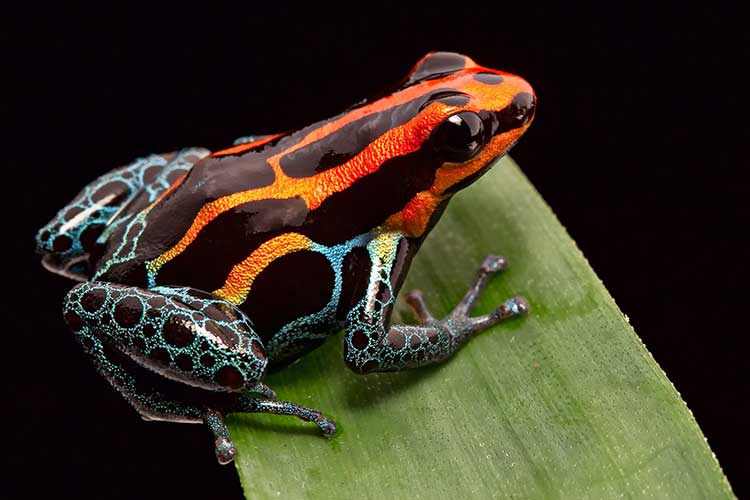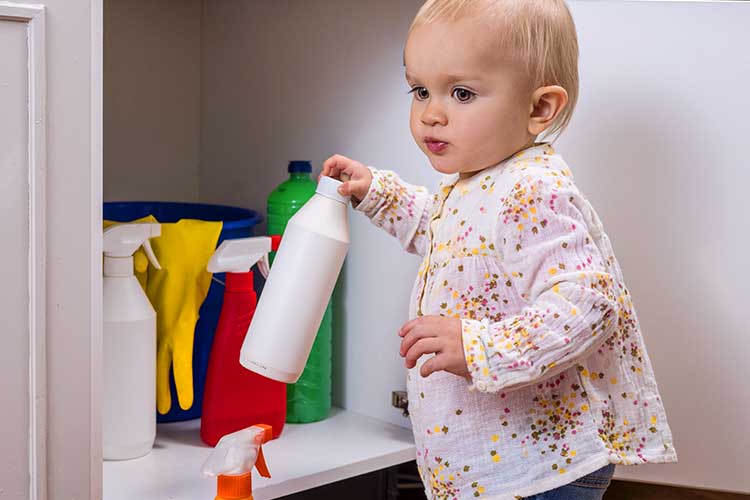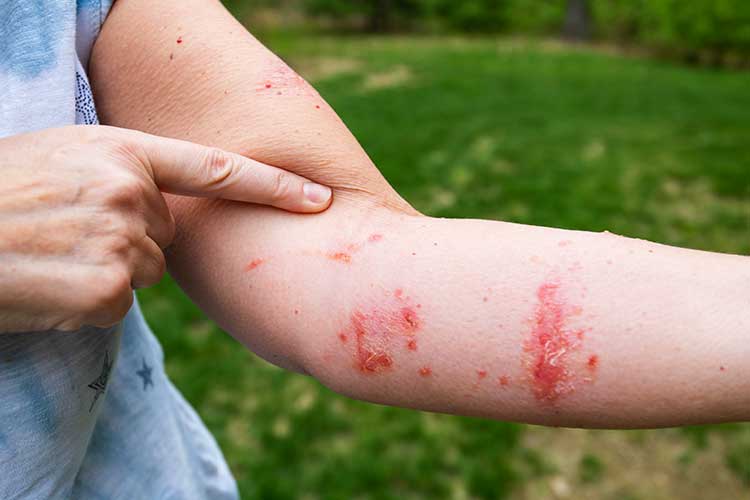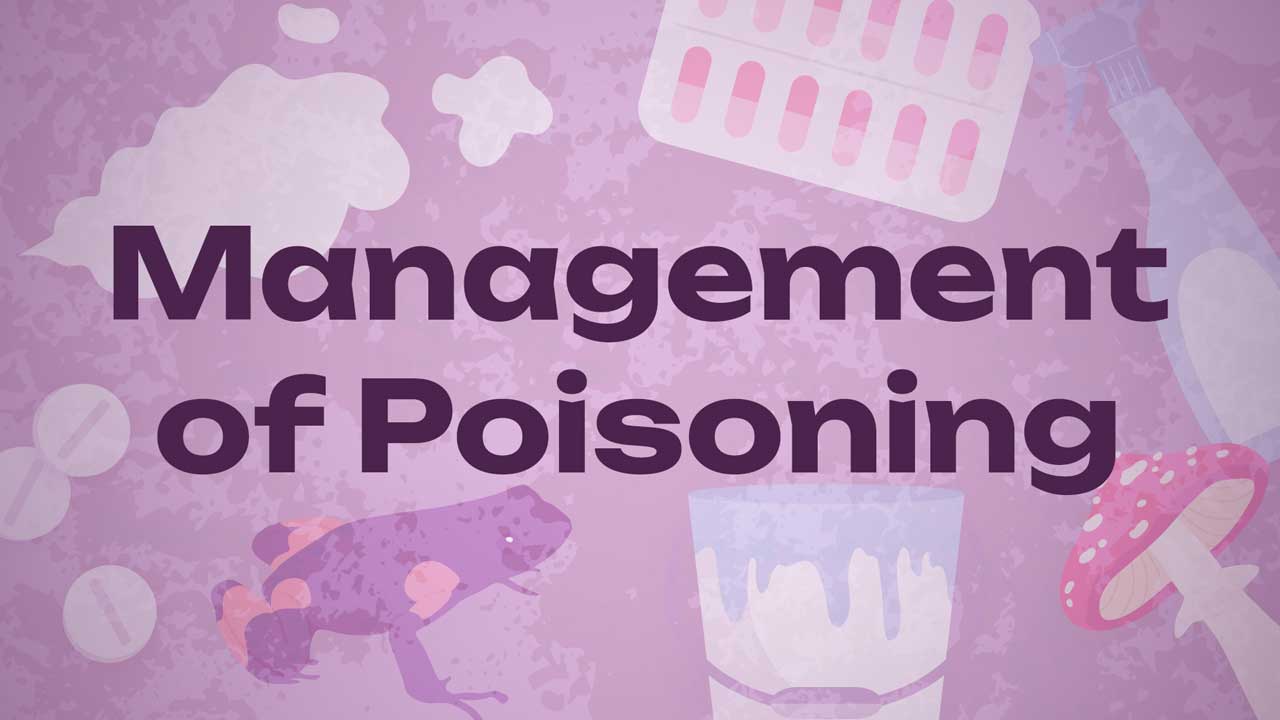If someone you are caring for has been poisoned, call the national Poisons Information Centre on 131 126.
The four poison information centres in Australia receive about 200,000 calls every year (ARDC 2024).
Furthermore, between 2021 and 2022, accidental poisoning was identified as the 9th most common cause of injury hospitalisation, with 8,800 people being hospitalised (AIHW 2023).
So, do you know what to do if soneone in your care is poisoned?
What is Poisoning?
Poisoning occurs when an individual ingests, inhales, injects or absorbs (through the skin) a substance that is harmful to human health (i.e. a poison) (ANZCOR 2021).
Poisoning may cause illness, injury or even death (Healthdirect 2023). This may occur soon after exposure, or in some cases, long-term exposure can cause the effects of the poison to develop over several years (Cleveland Clinic 2024).
Some substances are always harmful upon exposure, while some are only harmful in higher concentrations, and others are only harmful when ingested. However, as long as a substance has the potential to cause harm in some way, it is a poison (Mayo Clinic 2024).
Poisons include:
- Medicines (over-the-counter or prescription)
- Herbal medicines or supplements
- Substances of abuse including alcohol and illicit drugs
- Chemicals (e.g. household cleaning products, pesticides, paints)
- Certain plants and fungi
- Cosmetics (e.g. nail polish)
- Poorly prepared or contaminated food
- Medicines for animals
- Carbon monoxide
- Toxins (poisons from living organisms)
- Venoms (toxins that are injected via an organism).
(Healthdirect 2023; ANZCOR 2021; NHS 2021)
Poisonous v Venomous: What’s the Difference?

Poison and venom are similar terms that both describe harmful substances. However, they are not interchangeable.
- Poisons enter the body via ingestion, inhalation or absorption. Poisonous animals may excrete toxins passively rather than actively attacking.
- Venom is actively injected into the body via a bite or sting, where it enters through a wound. It has evolved to serve animals’ specific purposes, such as self-defence or incapacitating prey.
(Fry & Jackson 2017; Lewis 2024)
For more information on the first-aid management of envenomation, see the Ausmed Article: Basic First-aid for the Envenomated Person (Snakes, Spiders and Insects).
Most Common Causes of Poisoning
Between 2021 and 2022, the most common causes of accidental poisoning hospitalisations were:
- Pharmaceuticals, which accounted for 80% of hospitalisations
- Chemicals and noxious substances
- Gases and vapours (e.g. exhaust fumes, carbon monoxide)
- Alcohol
- Organic solvents and halogenated hydrocarbons
- Pesticides.
(AIHW 2023)
Who is at Risk of Being Poisoned?
People of all ages may become poisoned, however, children aged between one and three are at increased risk because of:
- Age-related physiological factors (thinner skin and faster respiratory rate)
- Natural curiosity and exploration (e.g. opening containers, mimicking adults, putting objects in their mouth)
- Inability to tell the difference between safe and unsafe substances.
(RCHM 2017; Better Health Channel 2023)
Despite this, most victims of poison-related deaths are adults (AIHW 2023).

Risk Factors for Poisoning
- Medication errors
- Occupational exposure
- Recreational poisoning
- Self-harm
- Substances being left unattended and easily accessible
- Poisons plants and mushrooms in the garden
- Changes to routine (e.g. visitors, moving house, holidays).
(Healthdirect 2023; Better Health Channel 2023)
Symptoms of Poisoning
Symptoms will depend on several factors, including the type of poison, the amount of exposure, and the person’s age, size and overall health (Healthdirect 2023).
Potential symptoms include:
- Skin-related symptoms (pain, itchiness, redness, blisters)
- Sweating
- Nausea and vomiting
- Drooling
- Headache
- Impaired vision
- Breathing difficulties
- Restlessness and agitation
- Numbness, tingling or twitching of the tongue and mouth
- Abdominal pain
- Throat pain
- Burn injuries in the mouth or throat
- Confusion
- Drowsiness
- Palpitations
- Loss of consciousness
- Seizures
- Respiratory arrest
- Cardiac arrest.
(Healthdirect 2023; ANZCOR 2021; NHS 2021)
While poisoning may be easily recognised due to the circumstances of the event, in some cases an individual may be unaware that they have been poisoned and attribute their symptoms to something else (ANZCOR 2021).

Acute Management of Poisoning
1. Avoid Poisoning Yourself or Others
There may be a risk of becoming poisoned yourself during the first aid and treatment of the patient (for example, if their clothing is contaminated).
In order to reduce the risk of harming yourself:
- Identify the suspected poison and handle it safely. If possible, identify the contaminated area and cordon it off.
- Don appropriate PPE if required.
- Be aware that if multiple people are affected by the poison there is a high risk of environmental contamination.
- Approach the poisoned person from upwind - this is especially important if the poison is a gas.
(ANZCOR 2021)
2. Send for an Ambulance
Call 000 for an ambulance. While the ambulance is arriving, you may also consider calling the Poisons Information Centre on 131 126 for advice.
Try to determine what the poison is, how much the patient has been exposed to and when it occurred.
(ANZCOR 2021)
3. Decontamination
Decontamination involves separating the patient from the poison, depending on how they have been exposed to the poison:
For Ingested Poison:
- Provide a sip of water to help wash out the patient’s mouth.
- DO NOT try to make the patient vomit or make them ingest a substance to neutralise acids or alkalis.
- If it is safe to do so, take a photo of the bottle/packet that the poison is in.
For Inhaled Poison:
- Move the patient to fresh air and loosen any tight clothing they are wearing. Ensure you don’t put yourself at risk of harm in doing so.
- Avoid breathing in fumes. Breathing apparatus may be required depending on the poison.
- Open doors and windows wide if safe to do so.
- If inflammable gases are suspected, do not use electronic appliances or turn on light switches.
For Poison in the Eye:
- Flood the affected eye with 0.9% sodium chloride, contact lens solution or cold water for 15 minutes, holding the eyelids open.
For Poison on the Skin:
- Remove any contaminated clothes and place them in a plastic bag unless you are uncertain about the potential for interactions between the poison and the plastic. Avoid contact with the poison when doing so.
- Flood the affected area with running water or irrigate with copious amounts of water or 0.9% sodium chloride. Do not use acids or alkalis on the skin to attempt to neutralise the poison.
- Use soap and water to gently wash the affected area and rinse thoroughly. Ideally, the patient will do this themself to decrease the risk of exposing rescuers to the poison.
(ANZCOR 2021; Healthdirect 2023)
4. Resuscitation and Supportive Care
- Ensure an ambulance has been called.
- If the patient is unresponsive and breathing normally:
- Place them in the lateral recumbent position
- Ensure their airway is clear.
- If the patient is unresponsive and NOT breathing normally:
- Commence chest compressions (Read: Adult Basic Life Support (BLS) Using DRSABCD)
- The safest way to provide ventilation is by using a self-inflating bag-mask apparatus
- If the patient has inhaled the poison, mouth-to-mouth ventilation is unlikely to pose a risk to the rescuer unless the patient is contaminated with the liquid form of the inhaled poison
- Perform chest compressions without ventilation if:
- There is poison on the patient’s lips
- Their lips or chin have been burned by corrosive chemicals, or
- You are unsure what the poison is.
(ANZCOR 2021)
5. Management of Specific Poisons
- If possible, determine:
- What the poison is
- How much of the poison the patient was exposed to
- When the patient was exposed to the poison.
- In cases of suspected self-poisoning, check for open medication packets and collect any vomit in a plastic container.
- Check for signs such as HAZMAT placards that could help to identify the poison.
- Seek advice from ambulance services.
- Any packets or bottles should be secured to help identify the poison in case a specific antidote is required.
- Some industries with higher exposure to certain poisons may stock specific antidotes and train workers in their use. Since hospitals may not always have these antidotes available, it's important to send the antidote with the poisoned person to the hospital.
While waiting for help, monitor the patient/resident’s airway, breathing and circulation and follow the Basic Life Support guidelines.
(ANZCOR 2021)
Preventing Poisoning
Strategies include:
- Storing dangerous substances such as cleaning chemicals securely
- Ensuring that dangerous substances can only be accessed by those who need to use them
- Labelling cleaning products, chemicals and medicines and keeping them in their original packaging
- Ensuring rooms are well-ventilated
- Ensuring medicines are properly stored
- Always following medicine instructions
- Always following the Rights of Medication Administration
- Administering medicines in a well-lit environment
- Checking for poisonous trees and plants
- Properly disposing of waste and unwanted medicines
- Wearing PPE when required
- Avoiding eating and drinking near poisons.
(Healthdirect 2023; ANZCOR 2021)
Test Your Knowledge
Question 1 of 3
What is the most common cause of poisoning?
Topics
References
- Australian and New Zealand Committee on Resuscitation 2021, Guideline 9.5.1 – First Aid Management of Poisoning, ANZCOR, viewed 23 September 2024, https://www.anzcor.org/home/first-aid-for-bites-stings-and-poisoning/guideline-9-5-1-first-aid-management-of-poisoning/
- Australian Institute of Health and Welfare 2023, Injury in Australia: Accidental Poisoning, Australian Government, viewed 23 September 2024, https://www.aihw.gov.au/reports/injury/accidental-poisoning
- Australian Research Data Commons 2024, Australian Poisoning Surveillance Initiative Databank, National Collaborative Research Infrastructure Strategy, viewed 23 September 2024, https://ardc.edu.au/project/national-poisons-information-centre-dataset/
- Better Health Channel 2023, Poisoning and Child Safety, Victoria State Government, viewed 24 September 2024, https://www.betterhealth.vic.gov.au/health/HealthyLiving/poisoning-and-child-safety
- Cleveland Clinic 2024, Poisoning, Cleveland Clinic, viewed 23 September 2024, https://my.clevelandclinic.org/health/diseases/poison
- Fry, B & Jackson, T 2017, Poison vs. Venom, Australian Academy of Science, viewed 18 September 2024, https://www.science.org.au/curious/people-medicine/poison-vs-venom
- Healthdirect 2023, Poisoning, Australian Government, viewed 23 September 2024, https://www.healthdirect.gov.au/poisoning
- Lewis, R 2024, ‘Venom’, Encyclopedia Britannica, 4 September, viewed 18 September 2024, https://www.britannica.com/science/venom
- Mayo Clinic 2024, Poisoning: First Aid, Mayo Clinic, viewed 23 September 2024, https://www.mayoclinic.org/first-aid/first-aid-poisoning/basics/art-20056657
- National Health Service 2021, Poisoning, NHS, viewed 24 September 2024, https://www.nhs.uk/conditions/poisoning/
- Royal Children's Hospital Melbourne 2017, Poisoning - Acute Guidelines For Initial Management, RCHM, viewed 24 September 2024, https://www.rch.org.au/clinicalguide/guideline_index/Poisoning_-_Acute_Guidelines_For_Initial_Management/
 New
New 
